The travel bug bit us, inviting us to sample a short trip by airplane and rental car to test
whether we still enjoy exploring, and to take a look at parts of northeast Texas (and Oklahoma
and Arkansas) which we hadn't seen before. Landing in Dallas, we headed north and west through
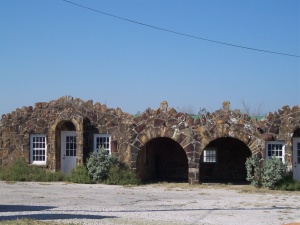 1930s tourist cabin
urban and exurban sprawl which soon yielded to farm and ranch land and tiny crossroads towns.
Dallas is just a few hours' drive from rangeland, mountains, forests, lakes, and farm pastures,
giving travelers who pick the byroads a glorious mix of natural beauty to enjoy.
1930s tourist cabin
urban and exurban sprawl which soon yielded to farm and ranch land and tiny crossroads towns.
Dallas is just a few hours' drive from rangeland, mountains, forests, lakes, and farm pastures,
giving travelers who pick the byroads a glorious mix of natural beauty to enjoy.
People have been crossing the state for many years and for many reasons: in Decatur, near the
Oklahoma border, a highway marker explained a cluster of roadside buildings: "Local businessman
E. F. Boydston purchased this site, a former feed lot, in 1927 for $400. Recognizing a potential
business opportunity in offering services to the traveling public, he built a wooden shed and gas
station in 1927. Travelers were allowed to build campfires during overnight stays, and by 1931
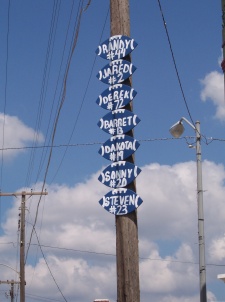 Durant Texas football players
Boydston added three wooden cabins with garages to the camp complex... It was closed in the 1960s
after a highway bypass built west of town diverted traffic from this area... One of the few intact
examples of tourist camps built throughout Texas in the mid-20th century..." Decatur remains small
but typical in the importance it gives to high school football. We found the names of team members
on almost every downtown corner, as the town prepared for the big game between Decatur and Coalgate.
Durant Texas football players
Boydston added three wooden cabins with garages to the camp complex... It was closed in the 1960s
after a highway bypass built west of town diverted traffic from this area... One of the few intact
examples of tourist camps built throughout Texas in the mid-20th century..." Decatur remains small
but typical in the importance it gives to high school football. We found the names of team members
on almost every downtown corner, as the town prepared for the big game between Decatur and Coalgate.
Next morning we reached McAlester, Oklahoma, where a large brick building commands the top of the hill.
At first we thought it must be the courthouse or a hospital, but on close inspection it turned out to
be a Scottish Rite Masonic Temple. Tours were offered, so we set off with our guide, the newly-hired
director of development for the Masons here, who are hoping to use this building and its resources
for a variety of community events and meetings. McAlester is one of the many towns which had reached
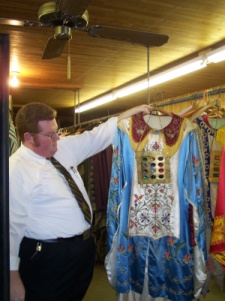 Historic costume
prominence during the heady days of coal mining, declining, however, as coal mining diminished in the
area. We learned that the Masons regard the Bible, the Koran, and the Torah as important holy works
and keep all three in their chapel. There are several special wings of the Masonic order: Scottish
Rite Masons concentrate on education, York Rite Masons study the traditions and customs of the order,
and Shriners raise funds for medical support for children. In McAlester, the Temple houses a clinic
for children with speech and learning problems. Perhaps the most surprising and impressive part of
the building is the theater. Critical to the purposes of this organization, because the traditions
are taught to members through pageants and dramatic presentations, the theater is a marvel. It has
a 90-foot-deep stage where rows upon rows of scenery can be arranged, a large auditorium decorated
lavishly with Egyptian designs in lively colors. We visited the makeup and costume rooms and
admired the beautiful and elegant costumes, including one treasure -- a robe designed for DeMille's
Historic costume
prominence during the heady days of coal mining, declining, however, as coal mining diminished in the
area. We learned that the Masons regard the Bible, the Koran, and the Torah as important holy works
and keep all three in their chapel. There are several special wings of the Masonic order: Scottish
Rite Masons concentrate on education, York Rite Masons study the traditions and customs of the order,
and Shriners raise funds for medical support for children. In McAlester, the Temple houses a clinic
for children with speech and learning problems. Perhaps the most surprising and impressive part of
the building is the theater. Critical to the purposes of this organization, because the traditions
are taught to members through pageants and dramatic presentations, the theater is a marvel. It has
a 90-foot-deep stage where rows upon rows of scenery can be arranged, a large auditorium decorated
lavishly with Egyptian designs in lively colors. We visited the makeup and costume rooms and
admired the beautiful and elegant costumes, including one treasure -- a robe designed for DeMille's
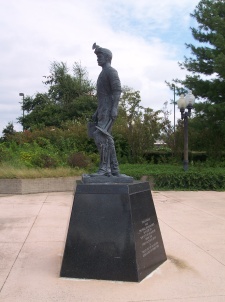 The Pioneer Miner
Ten Commandments and actually worn in that movie.
The Pioneer Miner
Ten Commandments and actually worn in that movie.
On our way from McAlester we paused at the memorial to the Pioneer Miner, which commemorates the coal
miners who died from injuries or disease in the course of their work. The legend says: "He may have
been killed, or suffered permanent injury, or black lung in his hazardous occupation. It was by his
labor that the early day economy of this area was built. He left with us an ethnic and cultural mix
that has enriched us all."
In Arkansas, not far from Hope, we found Historic Washington State Park, which is an entire town,
population about 147 today but in the 1850s a commanding city of over 3,000 people, with courthouse,
stores, schools, churches and what then seemed to be an exciting future. Located squarely on the road
leading from the Red River to San Antonio, Texas, it hosted famous people like Sam Houston and Davy
Crockett and James Bowie. The road was also part of the Trail of Tears traveled by the displaced
Cherokee people. But as railroads began to approach, the citizens of Washington wanted no part
of the threatened incursions of undesirables and industrial pollution. So the railroad bypassed
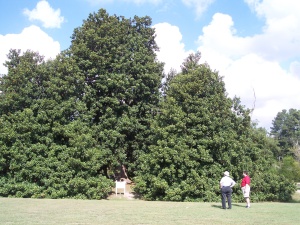 Magnolia tree
Washington and went through Hope instead, and today Old Washington is almost empty of cars and
people (preserved by the simple good luck that no Civil War battles came closer than six miles away).
Magnolia tree
Washington and went through Hope instead, and today Old Washington is almost empty of cars and
people (preserved by the simple good luck that no Civil War battles came closer than six miles away).
We began our tour with the courthouse, beautifully preserved (on special occasions, a reenactment of
an actual trial takes place, but in the newer courthouse at the other end of the village). We opted
for the full tour, which covered buildings at both ends of town -- the young tour guides kept in touch
by radio so that we found our guide as we drove from one site to another, visiting several homes,
including the imposing home of a Jewish merchant, Abraham Block, and his family. This home and
others had been kept in family hands until they were given to the Old Washington Restoration Foundation.
 Downtown Pendleton Texas
High points included a couple of homes from the 1850s which have been preserved on their original
locations, a gun museum and a printing museum (the editor of the local newspaper purchased the first
stove in town, in 1852, when the winter was so cold that the ink in his shop froze). One house has
been turned into a most impressive demonstration where walls and ceilings have been cut away to show
construction details, and rollers and wallpaper samples illustrate the finishing details from more
than a century ago. Possibly the most dramatic sight in the village was the magnolia tree planted
in 1839. It is so large that some of its branches, touching the ground, have developed root systems
and are growing their own branches into the canopy.
Downtown Pendleton Texas
High points included a couple of homes from the 1850s which have been preserved on their original
locations, a gun museum and a printing museum (the editor of the local newspaper purchased the first
stove in town, in 1852, when the winter was so cold that the ink in his shop froze). One house has
been turned into a most impressive demonstration where walls and ceilings have been cut away to show
construction details, and rollers and wallpaper samples illustrate the finishing details from more
than a century ago. Possibly the most dramatic sight in the village was the magnolia tree planted
in 1839. It is so large that some of its branches, touching the ground, have developed root systems
and are growing their own branches into the canopy.
We returned to the Dallas airport by way of another series of small towns, including Pendleton, Texas.
These towns, like so many through the mid-South, are so tiny and so devastated by decades of economic
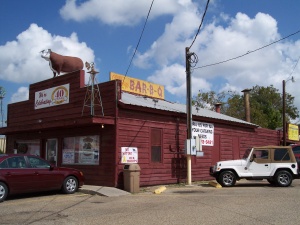 Mikeska's barbecue
blight that there is scarcely an occupied building. We had been hoping for lunch in Pendleton but it
was not to be. Instead, we reached the outskirts of Temple, near Fort Hood, and found Clem Mikeska's
Barbecue. The Mikeska brothers have been running restaurants in Central Texas for decades and have
the formulas down pat. Their combination plate (we had sausage and beef, plus two sides -- greens
or beans or slaw or potatoes ) is a terrific bargain.
Mikeska's barbecue
blight that there is scarcely an occupied building. We had been hoping for lunch in Pendleton but it
was not to be. Instead, we reached the outskirts of Temple, near Fort Hood, and found Clem Mikeska's
Barbecue. The Mikeska brothers have been running restaurants in Central Texas for decades and have
the formulas down pat. Their combination plate (we had sausage and beef, plus two sides -- greens
or beans or slaw or potatoes ) is a terrific bargain.
We have a lot of fun kidding each other that one or the other of us is in charge of serendipity, but
it seems that the sights we like best are the ones we didn't expect to see. We learned that we still
enjoy traveling, that we'd rather be in our truck than in an airplane, that we're more tolerant of
bad motel situations when we know we'll be back to our own bed in a few days, that we love testing
local cafe cooking, and that the best part of any journey is the surprise around the next bend.
 1930s tourist cabin
urban and exurban sprawl which soon yielded to farm and ranch land and tiny crossroads towns.
Dallas is just a few hours' drive from rangeland, mountains, forests, lakes, and farm pastures,
giving travelers who pick the byroads a glorious mix of natural beauty to enjoy.
1930s tourist cabin
urban and exurban sprawl which soon yielded to farm and ranch land and tiny crossroads towns.
Dallas is just a few hours' drive from rangeland, mountains, forests, lakes, and farm pastures,
giving travelers who pick the byroads a glorious mix of natural beauty to enjoy.
 Durant Texas football players
Durant Texas football players Historic costume
Historic costume The Pioneer Miner
The Pioneer Miner Magnolia tree
Magnolia tree Downtown Pendleton Texas
Downtown Pendleton Texas Mikeska's barbecue
Mikeska's barbecue